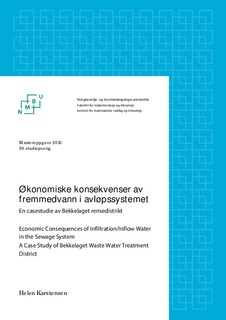| dc.description.abstract | Stor andel fremmedvann i avløpssystemet medfører unødvendig store forurensningsutslipp, større kostnader til drift og større investeringer i avløpsanleggene enn det ellers hadde vært behov for, og blir sett på som et betydelig problem for samfunnet (Lindholm & Bjerkholt 2012). I denne oppgaven vil det bli gjort en økonomisk vurdering av alle konsekvensene som fremmedvann fører til for å avgjøre om arbeid med reduksjon av fremmedvann bør prioriteres. Oppgaven har Oslo kommune og Bekkelaget rensedistrikt som studieområde.
Fremmedvann defineres som alt vann i avløpsledningen som ikke kommer fra spillvannsproduksjon. Overvann i fellessystemet inngår som fremmedvann i denne oppgaven.
For å samle nødvendig informasjon er sentrale personer i sektoren intervjuet og sentrale vedtak, rapporter og handlingsplaner innhentet og analysert. Estimatene i denne oppgaven er hovedsakelig basert på kvalifiserte faglige anslag.
De økonomiske konsekvensene av fremmedvann er hovedsakelig knyttet til drift, miljø og investeringer til avløpsanlegg. Avhengig av beregningsgrunnlaget og anvendt metode vil størrelsen på kostnaden variere mye. Basert på de laveste estimatene blir den årlige kostnaden for fremmedvann 35 mill. kr, mens de høyeste estimatene vil gi en årlig kostnad på
313,2 mill. kr. Utslipp av fosfor og hvordan dette utslippet verdsettes er den variabelen som har størst betydning for fremmedvannets totale kostnad. Hvis en utvidelse av renseanlegg tillegges fremmedvann vil den årlige kostnaden øke med 138 mill. kr. Disse anslagene inkluderer ikke investeringer knyttet til renseanlegg, pumpestasjoner og ledningsnett som ut fra en kvalitativ vurdering ble vurdert til å ha stor betydning. Dermed er de utregnet kostnadene en stor underestimering av hva fremmedvann egentlig koster.
Ut fra samfunnsøkonomiske betraktninger gjennomført i denne studien blir fremmedvann ansett som viktig og bør vektlegges i beslutninger om hvilke tiltak som skal iverksettes på avløpsnettet. Her vil det være avgjørende om det tas utgangspunkt i det lave eller høye estimatet for hva den årlige kostnaden for fremmedvann er. Videre har denne studien har avdekket et stort behov for grundigere utredninger om temaet fremmedvann.
Abstract
Extraneous water from infiltration/inflow sources causes unnecessary pollution emissions, greater operating costs and larger investments in wastewater plants than needed. In this study it will be made an economic evaluation of all the consequences that infiltration/inflow water causes to determine whether elimination of infiltration/inflow by sewer system rehabilitation should be prioritized.
Infiltration/inflow water is defined as all water in the sewage system that do not come from wastewater production. Stormwater is included in this definition.
In order to gather the significant information for this paper a range of key individuals from the sector were interviewed. Further key policies, reports and action plans were obtained and analyzed. The estimates used is mainly based on qualified professional guesswork and calculation, called guesstimate.
The economic consequences of infiltration/inflow water are mainly related to operation, environmental and investments to sewerage systems. Depending on the calculation method and guesstimates used the cost will vary widely. Based on the lowest estimates the annual cost of infiltration/inflow water is NOK 35 mill. while the highest estimates will give an annual cost of NOK 313,5 mill. Emissions of phosphorus and how the emissions are valued is the variable that has the greatest impact on the total cost of infiltration/inflow water. If an expansion of the water treatment plant is included the annual cost increases by NOK 138 mill. These estimates do not include investments related to water treatment plants, pumping stations and pipe system that was considered to be of great importance. Hence is the calculated cost a large underestimation of what infiltration/inflow water really costs.
Based on socioeconomic considerations conducted in this study infiltration/inflow water is considered important and should be emphasized in decisions about what kind of rehabilitation work should be initiated at the sewerage network. Here it will be crucial whether it is based on the low or high estimate of the annual cost. Further this study has revealed a great need for more thorough studies on the topic infiltration/inflow water. | nb_NO |
